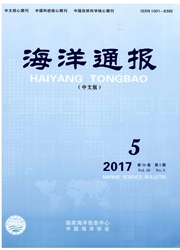

 中文摘要:
中文摘要:
开展了Envisat ASAR溢油检测的影响因素分析,以2010年墨西哥湾溢油事故为例,主要从入射角和海面风速两个方面,开展了油膜和海水的后向散射特征分析,给出了适合ASAR溢油检测的入射角与海面风速范围.对入射角的分析表明,在中等风速条件下,入射角在28°~36°的范围内,油膜和海水的后向散射值相差大于5dB,两者在SAR影像上容易区分;在入射角为20°~24°时,油膜和海水的后向散射值相差较小;在入射角大于37°时,油膜的后向散射值接近ASAR的系统噪声.对海面风速的分析显示,适合ASAR影像溢油检测的风速范围是3.0~7.0 m/s;风速小于3m/s时,油膜和海水的后向散射值均较低;风速为9.7 m/s时,油膜和海水在ASAR影像上难以区分.
 英文摘要:
英文摘要:
In this paper,an analysis of the effects on the oil spill detection by Envisat ASAR was conducted.Taking the oil spill disaster occurred in the Mexico Gulf in 2010 as an example,the analysis of the influenccs of incidence angle and sea surface wind speed on oil spill detection were carried out,and the backscattering features of ocean water and oil spill were analyzed.Then,the optimal conditions for oil spill observation and detection was proposed.The analysis on incidence angle indicated that under the conditions of mediate sea surface wind speed,the incidence angle of 28°~36° was beneficial to detect oil spill,and about 5dB backscattering difference existed for oil slick and sea water; for the incidence angle of 20°~24°,the difference narrowed ; for the incidence angles larger than 37°,the backscattering value of oil spill was close to the system noise of ASAR.The analysis on the sea surface wind manifested that the best wind speed for oil spill detection was 3.0~7.0 m/s.When wind speed was less than 3m/s or stronger than 9.4 m/s,oil spill and sea water were hard to distinguish from each other by SAR.
 同期刊论文项目
同期刊论文项目
 同项目期刊论文
同项目期刊论文
 期刊信息
期刊信息
